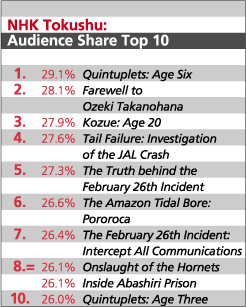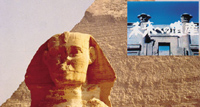|
"Something new"
We need some fresh air in this organization.
Let's create a new kind of television." With that rallying cry,
NHK Tokushu was born as a new approach to program production that broke
down invisible walls between departments and marshaled NHK's vast capabilities.
To oversee the initiative, the NHK Special Programs Division was created.
This division forged a new approach to creating programs, soliciting
ideas from all over Japan and harnessing the energy of NHK's entire
workforce.
The guiding concepts in this effort were
experimentation and exclusives. Experimentation meant aggressively pursuing
new techniques and content. Exclusivity meant not only cultivating a
sixth sense for a scoop, but also being committed to revealing important
issues that had been overlooked. The spirit of "N-Toku," as
NHK Tokushu was nicknamed, was to do something new, a phrase that became
a lasting watchword for program directors and producers.
Portable video revolution
In 1976 came a technological breakthrough
that would change television forever: the introduction of the portable
videotape cameras that enabled electronic news gathering (ENG). These
video cameras became a key weapon in the N-Toku battle to produce experimental
and scoop-oriented programs.
The first N-Toku milestone was Frozen
Spring: Journey on the Okhotsk Coast. Footage taken from a Cessna
flying over ice floes in the Sea of Okhotsk was made possible by the
new portable video camera's ability to make long recordings. Zen
Temple: The Eiheiji, which won the Prix Italia for documentaries,
delved into the world of Buddhist priests and recorded their ascetic
lives on portable video cameras.
N-Toku pioneered a variety of technologies
and methods that opened up new possibilities for television.
|
|
Re-examining recent history
N-Toku began by turning its attention to
historical events that had shaped contemporary Japan, examining the
path Japan and its people had followed in their relations with the world.
Founders of the Meiji Era painted
a portrait of late 19th century Japan, as the nation struggled through
treaty revisions and the Russo-Japanese war. Mitsuko
recounted the life story of a Japanese woman who embraced internationalism
at the end of the 19th century.
In Document Showa
and Record of Upheaval, N-Toku
traced the events that culminated in the Second World War, exploring
Japan's path to war.
Postwar Japan
illuminated the roots of contemporary Japan by examining the policies
of the Allied occupation's GHQ, while What
the World Did: Isomura Hisanori's Tour of Postwar History considered
the contemporary significance of events that became turning points in
history.

Early days

Two major programs laid the foundation for the NHK Tokushu initiative.
Our World in the 70's, a 90-min.
series aired once a month from 1970-75, roamed the world covering
human development and peace issues. Legacy
for the Future, a film documentary exploring the contemporary
relevance of cultural treasures around the world, was broadcast
as a 17-part series in 1974-75. These two programs were the wellspring
from which the great N-Toku river flowed. |
Major Programs of NHK Tokushu 1976-82 |



